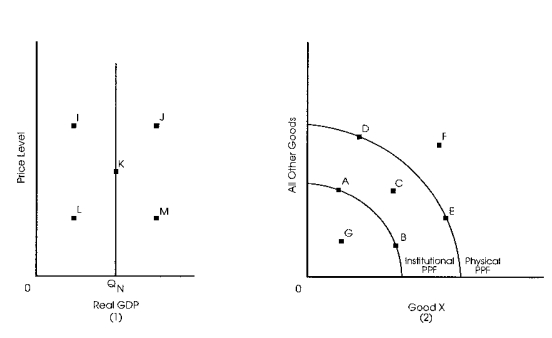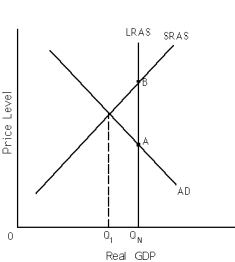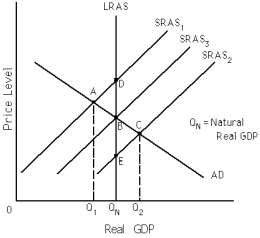A) greater than Natural Real GDP.
B) equal to Natural Real GDP.
C) equal to the Real GDP produced at full employment.
D) less than Natural Real GDP.
E) b and c
Correct Answer

verified
Correct Answer
verified
Multiple Choice
Exhibit 9-5
 -Refer to Exhibit 9-5.Picture an AD curve intersecting an SRAS curve at Point J on graph (1) . Which point(s) would this correspond to on graph (2) ?
-Refer to Exhibit 9-5.Picture an AD curve intersecting an SRAS curve at Point J on graph (1) . Which point(s) would this correspond to on graph (2) ?
A) A or B
B) C
C) E or F
D) F
E) G
Correct Answer

verified
Correct Answer
verified
Multiple Choice
When the economy is producing Real GDP at a level at which the LRAS curve intersects the AD curve the economy is
A) in a recessionary gap.
B) in long-run equilibrium.
C) in an inflationary gap.
D) operating at less than full-employment output.
Correct Answer

verified
Correct Answer
verified
Multiple Choice
Exhibit 9-1
 -Refer to Exhibit 9-1.The economy is currently producing Q1.At this level of Real GDP,the economy is in a(n)
-Refer to Exhibit 9-1.The economy is currently producing Q1.At this level of Real GDP,the economy is in a(n)
A) inflationary gap.
B) recessionary gap.
C) unemployment gap.
D) high Real GDP gap.
E) none of the above
Correct Answer

verified
Correct Answer
verified
Multiple Choice
If the natural unemployment rate is 5.5 percent,then the economy is in an inflationary gap when the actual unemployment rate is
A) more than 5.5 percent.
B) less than 5.5 percent.
C) 0 percent.
D) 5.5 percent.
Correct Answer

verified
Correct Answer
verified
Multiple Choice
A recessionary gap exists if (actual) Real GDP is __________ Natural Real GDP.
A) less than
B) greater than
C) equal to
D) b and c
E) none of the above
Correct Answer

verified
Correct Answer
verified
Multiple Choice
If an economy's institutional production possibilities frontier (institutional PPF) shifts rightward,the economy's
A) natural unemployment rate rises.
B) natural unemployment rate falls.
C) Natural Real GDP declines.
D) physical PPF shifts leftward.
E) physical PPF shifts rightward.
Correct Answer

verified
Correct Answer
verified
Multiple Choice
Exhibit 9-3
 -Refer to Exhibit 9-3.The economy is in short-run equilibrium and has an inflationary gap at point
-Refer to Exhibit 9-3.The economy is in short-run equilibrium and has an inflationary gap at point
A) A.
B) B.
C) C.
D) D.
E) E.
Correct Answer

verified
Correct Answer
verified
Multiple Choice
Some economists believe the economy is self-regulating.What does this mean?
A) It means the economy can remove itself from recessionary and inflationary gaps and produce at Natural Real GDP.
B) It means the economy is always in long-run equilibrium producing Natural Real GDP.
C) It means that inflationary gaps naturally change into recessionary gaps.
D) It means that recessionary gaps naturally change into inflationary gaps.
E) c and d
Correct Answer

verified
Correct Answer
verified
Multiple Choice
If the natural unemployment rate is 7 percent and the current unemployment rate is 5 percent,then the economy is
A) producing more Real GDP than it does at full employment.
B) in a recessionary gap.
C) producing less Real GDP than it does at full employment.
D) a and b
E) b and c
Correct Answer

verified
Correct Answer
verified
True/False
Business-cycle macroeconomics involves increases in Real GDP that result from a rightward-shifting LRAS curve.
Correct Answer

verified
Correct Answer
verified
Multiple Choice
The frictional unemployment rate is 2.5 percent,the structural unemployment rate is 3.1 percent,and the current unemployment rate (in the economy) is 5.6.The economy is in
A) an inflationary gap producing more than Natural Real GDP.
B) a recessionary gap producing more than Natural Real GDP.
C) an inflationary gap producing Natural Real GDP.
D) a recessionary gap producing less than Natural Real GDP.
E) long-run equilibrium.
Correct Answer

verified
Correct Answer
verified
Multiple Choice
An inflationary gap exists when AD and SRAS
A) fail to intersect.
B) intersect to the right of Natural Real GDP.
C) intersect to the left of Natural Real GDP.
D) both have a positive slope.
Correct Answer

verified
Correct Answer
verified
Multiple Choice
Suppose the economy's short-run equilibrium point is to the left of the Natural Real GDP.Which of the following is true?
A) The economy is in an inflationary gap.
B) The economy is in a recessionary gap.
C) The economy is in long-run equilibrium.
D) This situation is actually impossible.
Correct Answer

verified
Correct Answer
verified
Multiple Choice
According to Say's law,
A) the demand curve is negatively sloped.
B) the supply curve is positively sloped.
C) supply creates its own demand.
D) economic units should produce those goods for which they are low-opportunity-cost producers.
Correct Answer

verified
Correct Answer
verified
True/False
In a self-regulating economy,wages will fall and prices will rise when there is an inflationary gap.
Correct Answer

verified
Correct Answer
verified
Multiple Choice
Exhibit 9-5
 -Refer to Exhibit 9-5.Assume that the economy starts off at point A on graph (2) with an effective minimum wage law in place.After inflation erodes the purchasing power of the minimum wage,the economy is likely to move to a point such as
-Refer to Exhibit 9-5.Assume that the economy starts off at point A on graph (2) with an effective minimum wage law in place.After inflation erodes the purchasing power of the minimum wage,the economy is likely to move to a point such as
A) B.
B) G.
C) F.
D) C.
E) None of the above, because the minimum wage has no influence on the amount of goods produced.
Correct Answer

verified
Correct Answer
verified
Multiple Choice
A necessary condition for a money economy to be self-regulating is that
A) wages must be flexible in an upward direction, but not in a downward direction.
B) the economy must always be operating on its institutional production possibilities frontier.
C) wages must be flexible in a downward direction, but not in an upward direction.
D) interest rates must be flexible in the credit market.
E) none of the above
Correct Answer

verified
Correct Answer
verified
Multiple Choice
Exhibit 9-3
 -Refer to Exhibit 9-3.If the economy is in short-run equilibrium at point A,
-Refer to Exhibit 9-3.If the economy is in short-run equilibrium at point A,
A) the (actual) unemployment rate is less than the natural unemployment rate.
B) the (actual) unemployment rate is equal to the natural unemployment rate.
C) the (actual) unemployment rate is greater than the natural unemployment rate.
D) the relationship between the (actual) unemployment rate and the natural unemployment rate cannot be determined from the available information.
Correct Answer

verified
Correct Answer
verified
True/False
In the long run,changes in aggregate demand will affect the level of Real GDP (but not the price level)in a self-regulating economy.
Correct Answer

verified
Correct Answer
verified
Showing 141 - 160 of 167
Related Exams